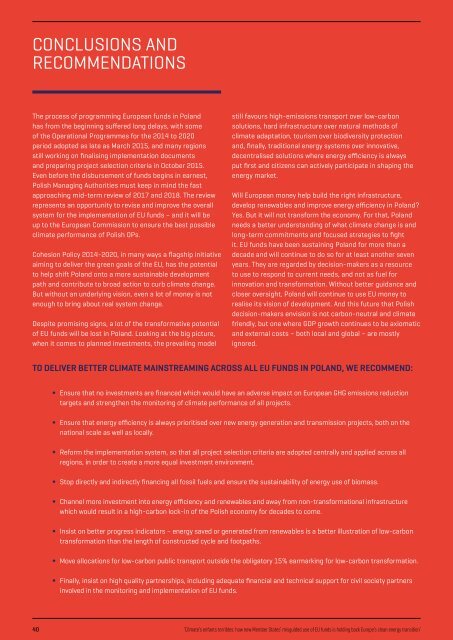ENFANTS TERRIBLES
enfants-terribles
enfants-terribles
You also want an ePaper? Increase the reach of your titles
YUMPU automatically turns print PDFs into web optimized ePapers that Google loves.
CONCLUSIONS AND<br />
RECOMMENDATIONS<br />
The process of programming European funds in Poland<br />
has from the beginning suffered long delays, with some<br />
of the Operational Programmes for the 2014 to 2020<br />
period adopted as late as March 2015, and many regions<br />
still working on finalising implementation documents<br />
and preparing project selection criteria in October 2015.<br />
Even before the disbursement of funds begins in earnest,<br />
Polish Managing Authorities must keep in mind the fast<br />
approaching mid-term review of 2017 and 2018. The review<br />
represents an opportunity to revise and improve the overall<br />
system for the implementation of EU funds – and it will be<br />
up to the European Commission to ensure the best possible<br />
climate performance of Polish OPs.<br />
Cohesion Policy 2014-2020, in many ways a flagship initiative<br />
aiming to deliver the green goals of the EU, has the potential<br />
to help shift Poland onto a more sustainable development<br />
path and contribute to broad action to curb climate change.<br />
But without an underlying vision, even a lot of money is not<br />
enough to bring about real system change.<br />
Despite promising signs, a lot of the transformative potential<br />
of EU funds will be lost in Poland. Looking at the big picture,<br />
when it comes to planned investments, the prevailing model<br />
still favours high-emissions transport over low-carbon<br />
solutions, hard infrastructure over natural methods of<br />
climate adaptation, tourism over biodiversity protection<br />
and, finally, traditional energy systems over innovative,<br />
decentralised solutions where energy efficiency is always<br />
put first and citizens can actively participate in shaping the<br />
energy market.<br />
Will European money help build the right infrastructure,<br />
develop renewables and improve energy efficiency in Poland?<br />
Yes. But it will not transform the economy. For that, Poland<br />
needs a better understanding of what climate change is and<br />
long-term commitments and focused strategies to fight<br />
it. EU funds have been sustaining Poland for more than a<br />
decade and will continue to do so for at least another seven<br />
years. They are regarded by decision-makers as a resource<br />
to use to respond to current needs, and not as fuel for<br />
innovation and transformation. Without better guidance and<br />
closer oversight, Poland will continue to use EU money to<br />
realise its vision of development. And this future that Polish<br />
decision-makers envision is not carbon-neutral and climate<br />
friendly, but one where GDP growth continues to be axiomatic<br />
and external costs – both local and global – are mostly<br />
ignored.<br />
TO DELIVER BETTER CLIMATE MAINSTREAMING ACROSS ALL EU FUNDS IN POLAND, WE RECOMMEND:<br />
• Ensure that no investments are financed which would have an adverse impact on European GHG emissions reduction<br />
targets and strengthen the monitoring of climate performance of all projects.<br />
• Ensure that energy efficiency is always prioritised over new energy generation and transmission projects, both on the<br />
national scale as well as locally.<br />
• Reform the implementation system, so that all project selection criteria are adopted centrally and applied across all<br />
regions, in order to create a more equal investment environment.<br />
• Stop directly and indirectly financing all fossil fuels and ensure the sustainability of energy use of biomass.<br />
• Channel more investment into energy efficiency and renewables and away from non-transformational infrastructure<br />
which would result in a high-carbon lock-in of the Polish economy for decades to come.<br />
• Insist on better progress indicators – energy saved or generated from renewables is a better illustration of low-carbon<br />
transformation than the length of constructed cycle and footpaths.<br />
• Move allocations for low-carbon public transport outside the obligatory 15% earmarking for low-carbon transformation.<br />
• Finally, insist on high quality partnerships, including adequate financial and technical support for civil society partners<br />
involved in the monitoring and implementation of EU funds.<br />
40<br />
‘Climate’s enfants terribles: how new Member States’ misguided use of EU funds is holding back Europe’s clean energy transition’


